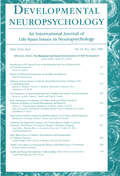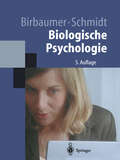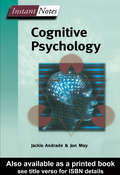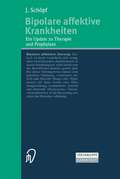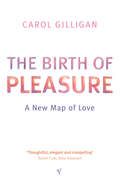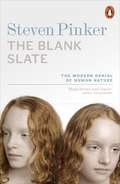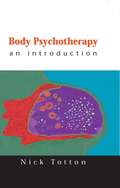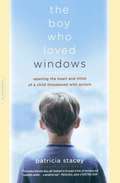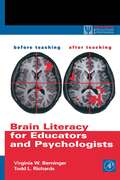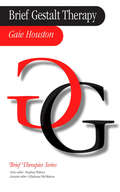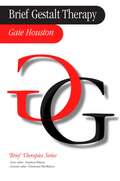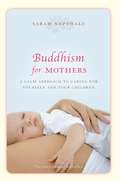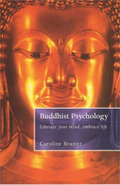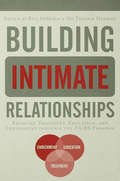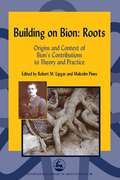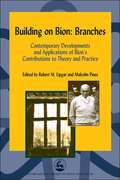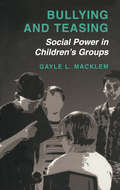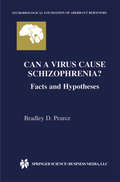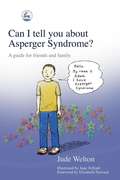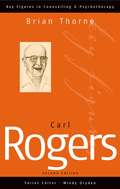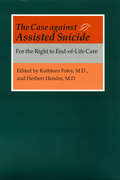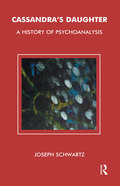- Table View
- List View
The Biological and Social Determinants of Child Development: A Special Double Issue of developmental Neuropsychology
by Steven M. LeharThe Biological and Social Determinants of Child Development stimulates cross-disciplinary communication and research collaboration in the field of child development. While the papers in this issue seem diverse in terms of topic and discipline, there are a number of common themes: *critical period for brain development and the importance of specific environmental input during this period; *importance of early brain development and enriched environments is supported in articles describing findings from human studies; *potential for brain plasticity following specialized retraining is found in a compelling paper demonstrating different profiles of brain activation for normal readers vs. those who have dyslexia and younger children at high risk for development of reading disabilities; and *critical period, brain plasticity, and parallel changes in developing behavior and brain structure and functioning. As a number of papers in this issue describe potential interventions, one is relevant because it describes the numerous factors that make results of such studies have the potential to generalize to larger populations. Putting the described papers in a broad perspective, the last article argues that we cannot understand the health status of a society without understanding the health-determining influences across the life course.
The Biological and Social Determinants of Child Development: A Special Double Issue of developmental Neuropsychology
by Steven M. LeharThe Biological and Social Determinants of Child Development stimulates cross-disciplinary communication and research collaboration in the field of child development. While the papers in this issue seem diverse in terms of topic and discipline, there are a number of common themes: *critical period for brain development and the importance of specific environmental input during this period; *importance of early brain development and enriched environments is supported in articles describing findings from human studies; *potential for brain plasticity following specialized retraining is found in a compelling paper demonstrating different profiles of brain activation for normal readers vs. those who have dyslexia and younger children at high risk for development of reading disabilities; and *critical period, brain plasticity, and parallel changes in developing behavior and brain structure and functioning. As a number of papers in this issue describe potential interventions, one is relevant because it describes the numerous factors that make results of such studies have the potential to generalize to larger populations. Putting the described papers in a broad perspective, the last article argues that we cannot understand the health status of a society without understanding the health-determining influences across the life course.
Biologische Psychologie (Springer-Lehrbuch)
by Niels Birbaumer Robert F. SchmidtBiologische Psychologie, das erfolgreiche Lehrbuch von Robert F. Schmidt und Niels Birbaumer, liegt in der 5. Auflage vor. Die biologischen Grundlagen unseres Verhaltens werden von physiologischen Prozessen bis zu komplexen Funktionen des ZNS, wie Bewusstsein, Motivation und Kognitionen, beschrieben. Neue Methoden der Biopsychologie und aktuelle Forschungsergebnisse wurden ergänzt. Die Didaktik des Lehrbuches macht es zu einer unverzichtbaren Grundlage für Prüfungsvorbereitung und Studium. Kapitelzusammenfassungen und Infoboxen kennzeichnen prüfungsrelevantes Wissen. Zahlreiche Abbildungen veranschaulichen das Zusammenwirken von Verhaltensprinzipien und physiologischen Gesetzmäßigkeiten.
BIOS Instant Notes in Cognitive Psychology (Instant Notes)
by Jackie Andrade Jon MayInstant Notes in Cognitive Psychology is a concise summary of the key theoretical and empirical topics in cognitive psychology, providing easy access to the core information in the field. The book can serve as a core text, supplemented by readings in the original literature, as a reference guide for students and lecturers alike, or as an ideal revision guide prior to exams.Instant Notes in Cognitive Psychology is intended primarily for students taking a first course in the subject, but can also be used as an introduction to the field for undergraduates and graduates from other subject areas.
BIOS Instant Notes in Cognitive Psychology (Instant Notes)
by Jackie Andrade Jon MayInstant Notes in Cognitive Psychology is a concise summary of the key theoretical and empirical topics in cognitive psychology, providing easy access to the core information in the field. The book can serve as a core text, supplemented by readings in the original literature, as a reference guide for students and lecturers alike, or as an ideal revision guide prior to exams.Instant Notes in Cognitive Psychology is intended primarily for students taking a first course in the subject, but can also be used as an introduction to the field for undergraduates and graduates from other subject areas.
The Birth Of Pleasure: A New Map of Love
by Carol GilliganLove, like falling rain, can revive an arid life. But how can we find the love that brings true pleasure? How can we avoid the tragic love, with its lessons of sacrifice and loss, so deeply embedded in our culture? 'Pleasure is a sensation. It is written into our bodies; it is an experience of delight, of joy'In this inspiring book, Carol Gilligan sets out to create a radical new map of love. Although old patriarchal structures have been challenged the underlying patterns remain: the channeling of boys into 'masculinity'; the anxiety of girls in adolescence, the silences between men and women, the split between our social and our inner voice. In her work with children, adolescents and couples in crisis, Gilligan came to see how this 'double consciousness' - already present in the violence and betrayal of ancient myths, like that of Oedipus - had developed over thousands of years. Hunting for a counter myth, she discovered the story of Psyche and Cupid, a haunting tale of love and the searching soul, a model of resistance which she uses to frame her quest, showing how joy can be discovered in the heart of pain. The Birth of Pleasure rings with the voices of girls and boys, mothers and fathers, lovers and couples and echoes with telling readings of familiar writers, from Greek tragedy to Anne Frank, from Shakespeare to Proust, from Freud to Toni Morrison. All of us will find something that we recognise - and with luck, this brilliant, compassionate, flame-like book could really change our lives.
The Blank Slate: The Modern Denial of Human Nature (Penguin Press Science Ser.)
by Steven Pinker"In a work of outstanding clarity and sheer brilliance Steven Pinker banishes forever fears that a biological understanding of human nature threatens humane values" - Helena Cronin, author of THE ANT and THE PEACOCK."A mind blowing, mind openingexposé. Pinker's profoundly positive arguments for the compatibility of biology and humanism are unrivalled for their scope and depth and should be mandatory, if disquieting, reading"Patricia Goldman-Rakic - Past President of the Society for Neuroscience.
Body Psychotherapy (UK Higher Education OUP Humanities & Social Sciences Counselling and Psychotherapy)
by Nick Totton"...a well-rooted resource for bodywork courses and a useful introductory text for a broad audience." Caduceus"It's not a big book but it's got a vast amount of information and knowledge in it. ...if you are interested in getting a good overall picture of the subject you couldn't do better." The FulcrumBody psychotherapy is an holistic therapy which approaches human beings as united bodymind, and offers embodied relationship as its central therapeutic stance. Well-known forms include Reichian Therapy, Bioenergetics, Dance Movement Therapy, Primal Integration and Process Oriented Psychology.This new title examines the growing field of body psychotherapy: Surveys the many forms of body psychotherapy Describes what may happen in body psychotherapy and offers a theoretical account of how this is valuable drawing in current neuroscientific evidence Defines the central concepts of the field, and the unique skills needed by practitioners Accessible and practical, yet grounded throughout in current researchBody Psychotherapy: An Introduction is of interest to practitioners and students of all forms of psychotherapy and counselling, and anyone who wants to understand how mind and body together form a human being.
The Boy Who Loved Windows: Opening The Heart And Mind Of A Child Threatened With Autism
by Patricia StaceyIn 1997, writer Patricia Stacey and her husband Cliff learned that their six-month-old son Walker might never walk or talk, or even hear or see. Unwilling to accept this grim prediction, they embarked on a five-year odyssey that took them into alternative medicine, the newest brain research, and toward a new and innovative understanding of autism. Finally their search led them to pioneering developmental psychiatrist Stanley Greenspan who helped them save their son and bring him into full contact with the world. This enthralling memoir, at once heart wrenching and hopeful, takes the reader into the life of one remarkable family willing to do anything to give their son a rich and emotionally full life. We stand witness as they struggle to elicit the first sign that Walker is connecting with them, and share in their fears, struggles, tiny victories, and eventual triumphs. The Boy Who Loved Windows is compelling and inspiring reading for parents and professionals who care for children with autism and other special needs. The book is also a stunning literary debut, of interest to anyone who cares about the lives of children and the passion of families who, against huge odds, put these children first.
Brain Literacy for Educators and Psychologists (ISSN)
by Virginia W. Berninger Todd L. RichardsAlthough educators are expected to bring about functional changes in the brain--the organ of human learning--they are given no formal training in the structure, function or development of the brain in formal or atypically developing children as part of their education. This book is organized around three conceptual themes: First, the interplay between nature (genetics) and nurture (experience and environment) is emphasized. Second, the functional systems of the brain are explained in terms of how they lead to reading, writing and mathematics and the design of instruction. Thirdly, research is presented, not as a finished product, but as a step forward within the field of educational neuropsychology. The book differs from neuropsychology and neuroscience books in that it is aimed at practitioners, focuses on high incidence neuropsychological conditions seen in the classroom, and is the only book that integrates both brain research with the practice of effective literacy, and mathematics instruction of the general and special education school-aged populations.
Brief Gestalt Therapy
by Ms Gaie Houston`Anybody with the slightest interest in brief therapy should read this book. Now that the initial controversy over brief therapy has begun to subside it is great to see how brief therapy works in practice. Gaie Houston's book is part of a series published by SAGE which sets out to do this - and hers is particularly illuminating and accessible. As she points out Gestalt is better equipped than many mainstream therapies to be applied to situations with extreme time constraints because it is both flexible and it acknowledges the part that can be played by other therapies. But what propels Houston's book out of the hum drum - or indeed the defensive (or offensive) diatribes about short therapy which have appeared over the past few years - is her vivid accounts of real-life sessions, both one to one and group, which punctuate the text' - Amazon Review Brief Gestalt Therapy demonstrates how the Gestalt approach can be used effectively in brief interventions with clients. Gestalt's distinctively integrative nature and emphasis on a highly co-operative working alliance, make it particularly suited to brief work. The book sets out the basic theory and principles of Gestalt and looks at each phase of the therapeutic process from initial assessment through the beginning and middle stages to the ending of the work. It presents clear, practical strategies for therapists to follow and in particular examines: } aspects of Gestalt which are especially relevant to brief work -} the elements of successful therapy -} ways of improving skills. Brief Gestalt Therapy includes vignettes and detailed case studies which bring the theory alive. It will contribute much to both existing literature on Gestalt therapy and also brief therapy, and will be invaluable to trainee and practising Gestalt therapists.
Brief Gestalt Therapy (PDF)
by Ms Gaie Houston`Anybody with the slightest interest in brief therapy should read this book. Now that the initial controversy over brief therapy has begun to subside it is great to see how brief therapy works in practice. Gaie Houston's book is part of a series published by SAGE which sets out to do this - and hers is particularly illuminating and accessible. As she points out Gestalt is better equipped than many mainstream therapies to be applied to situations with extreme time constraints because it is both flexible and it acknowledges the part that can be played by other therapies. But what propels Houston's book out of the hum drum - or indeed the defensive (or offensive) diatribes about short therapy which have appeared over the past few years - is her vivid accounts of real-life sessions, both one to one and group, which punctuate the text' - Amazon Review Brief Gestalt Therapy demonstrates how the Gestalt approach can be used effectively in brief interventions with clients. Gestalt's distinctively integrative nature and emphasis on a highly co-operative working alliance, make it particularly suited to brief work. The book sets out the basic theory and principles of Gestalt and looks at each phase of the therapeutic process from initial assessment through the beginning and middle stages to the ending of the work. It presents clear, practical strategies for therapists to follow and in particular examines: } aspects of Gestalt which are especially relevant to brief work -} the elements of successful therapy -} ways of improving skills. Brief Gestalt Therapy includes vignettes and detailed case studies which bring the theory alive. It will contribute much to both existing literature on Gestalt therapy and also brief therapy, and will be invaluable to trainee and practising Gestalt therapists.
Buddhism for Mothers: A calm approach to caring for yourself and your children
by Sarah NapthaliParenthood can be a time of great inner turmoil for a woman, yet parenting books invariably focus on nurturing children rather than the mothers who struggle to raise them. This book is different. It is a book for mothers.Buddhism for Mothers encourages mothers to gain the most joy out of being with their children. How can this be done calmly and with a minimum of anger, worry and negative thinking? How can mothers negotiate the changed conditions of their relationships with partners, family and even with friends?Using Buddhist practices, Sarah Napthali offers coping strategies for the day-to-day challenges of motherhood that also allow space for deeper reflection about who we are and what makes us happy. By acknowledging the sorrows as well as the joys of mothering Buddhism for Mothers can help you shift your perspective so that your mind actually helps you through your day rather than dragging you down. This is Buddhism at its most accessible, applied to the daily realities of ordinary parents.
Buddhist Psychology: Beyond The Prison Of Self
by Caroline BrazierWestern therapeutic approaches have often put considerable emphasis on building self-esteem and enhancing a positive sense of self. This book challenges the assumption behind this approach. Most of us protect ourselves against being fully alive. Because we fear loss and pain, we escape by withdrawing from experiences and distracting ourselves with amusements. We fall into habitual ways of acting and limit our experience to the familiar. We create an identity which we think of as a 'self', and in so doing imprison our life-energy.For 2500 years Buddhism has developed an understanding of the way that we can easily fall into a deluded view. It has shown how the mind clings to false perceptions and tries to create permanence out of an ever changing world. Written by a practising therapist and committed Buddhist, this book explores the practical relevance of Buddhist teachings on psychology to our everyday experience. By letting go of our attachment to self, we open ourselves to full engagement with life and with others. We step out of our self-made prison.
Building Intimate Relationships: Bridging Treatment, Education, and Enrichment Through the PAIRS Program
by Rita DeMaria Mo Therese HannahFirst Published in 2003. Routledge is an imprint of Taylor & Francis, an informa company.
Building Intimate Relationships: Bridging Treatment, Education, and Enrichment Through the PAIRS Program
by Rita DeMaria Mo Therese HannahFirst Published in 2003. Routledge is an imprint of Taylor & Francis, an informa company.
Building on Bion: Origins and Context of Bion's Contributions to Theory and Practice
by Robert Lipgar Malcolm Pines'Two volumes of original papers by leading thinkers and practitioners of group therapy... The diverse collection that has informed and stimulated my thinking.' - International Journal of Group Psychotherapy 'The concepts that I liked were about the truth, the unknowable and unknown, and the functions he devised to communicate what is going on in the patients' world to other psychoanalyst. I am glad that I read these books with their wide range of ideas and I have gained insights which will make me more aware in my psychodrama practice.' - British Journal of Psychodrama. 'The book begins with a wonderful introduction by James Grotstien, a theorist whose grasp of Bion is enriched by his own formidable ideas. He sets the stage for what's to follow, toucing on Bion's groundbreaking work with groups, his formalizing of psychotic experience and several key concepts, like Bion's elaboration on the concept of projective identification. Grotstien's prose is remarkable. He conveys ideas about the most complex internal states with a clarity and reach that is unparalled, even by Bion himself. This is without a doubt a richly rewarding and ultimately exhausting text.' - www.mentalhelp.net This stimulating collection of papers by distinguished international contributors from the fields of psychoanalysis, group analysis, management consultancy and social science explores formative influences affecting Bion's emotional and intellectual development. The authors revisit in depth the origins of Bion's ideas, setting them in the context of his World War I experiences, his contact with Trotter, and his later work with the Tavistock Clinic and psychoanalysis. Chapters discuss the roots of his epistemology, re-examining and extending basic assumption theory; links between Bion and Foulkes; group mentality and Bion in Italy. Through these the spirit and shape of his work can be discovered by those new to Bion, and rediscovered by those who feel well acquainted with him. This is a collection of original and insightful papers which, along with its companion volume Building on Bion: Branches, will not only deepen understanding of Bion's contributions to theory and practice, but will also be invaluable to those who work with groups, in both therapeutic and management contexts.
Building on Bion: Contemporary Developments and Applications of Bion's Contributions to Theory and Practice
by Robert Lipgar Malcolm Pines'This book has contributions, largely related to group analysis, from an international selection of well-known group analysts, psychologists, psychiatrists and academics. There is a very clear overview and précis of Bions's thoughts by James Grotstein followed by ten chapters each developing an aspect of Bion's ideas and work'. - Journal of Analytical Psychology 'Intended to deepen understanding of Bion's significant contributions in addition to assisting practitioners in the field of group analysis, these volumes constitute an impressive tribute to Bion, his work, and its current and future applications.' - Hamilton Alumni Review The enduring influence of Bion's work - the many rich applications of his ideas to group psychology, organizational dynamics and group therapy in the present day and looking to the future - is the central theme of this book. Chapters by distinguished international contributors from the fields of psychoanalysis, group analysis, management consultancy and social science cover work with large groups, Bion and the Tavistock conferences, and his ideas about thinking and learning, dreams and mentality. They clearly demonstrate Bion's originality and passion as he sought the distinctive essence of psychoanalytic learning and how such a pursuit and such learning can be shared and advanced. This is a collection of original and insightful papers which, along with its companion volume Building on Bion: Roots, deepens understanding of Bion's contributions to theory and practice, and is invaluable to those who work with groups, in both therapeutic and management contexts.
Bullying and Teasing: Social Power in Children’s Groups
by Gayle L. Macklem-Addresses the problem of bullying as an interactive social system with emphasis on the contributions of family, community, and culture, as well as the school. -Gives concrete advice for successful intervention with both bullies, their victims, and bystanders. -Examines the nature of teasing behaviors so the reader understands the difference between aggressive and destructive teasing and teasing that may be tolerated.
Can a Virus Cause Schizophrenia?: Facts and Hypotheses (Neurobiological Foundation of Aberrant Behaviors #6)
by Bradley D. PearceCan I tell you about Asperger Syndrome?: A guide for friends and family (PDF)
by Elizabeth Newson Jane Telford Jude WeltonMeet Adam - a young boy with AS. Adam invites young readers to learn about AS from his perspective. He helps children understand the difficulties faced by a child with AS - he tells them what AS is, what it feels like to have AS and how they can help children with AS by understanding their differences and appreciating their many talents. This illustrated book is ideally suited for boys and girls between 7 and 15 years old and also serves as an excellent starting point for family and classroom discussions.
Carl Rogers (2nd edition) (PDF)
by Professor Brian Thorne`Brian Thorne has arguably become the UK's leading authority on Carl Rogers and his work, gaining this reputation by producing books which ooze many of the qualaties that Rogers himslef espoused - frankness, clarity, sensivity, insightfullness, thoroughness, humility and genorosity of spirit. This book will not disappoint the reader on any of these fronts. I would defy any person-centred practitioner to read it without, at various times, learning something new, being moved, inspired, challenged and entertained' - Ipnosis As founder of the person-centred approach, Carl Rogers (1902-1987) is arguably the most influential psychologist and psychotherapist of the 20th century. Providing unique insights into his life and a clear explanation of his major theoretical ideas, this book offers an accessible introduction for all practitioners and students of the person-centred approach. Written by Brian Thorne, leading person-centred practitioner and bestselling author, the Second Edition explores the continuing influence of Rogers since his death and the development of person-centred therapy internationally. Drawing on his experience of having known and worked with Rogers, Brian Thorne beautifully captures the way in which Rogers worked with clients and from that, draws out the practical implications of what is, in effect, a functional philosophy of human growth and relationships.
The Case against Assisted Suicide: For the Right to End-of-Life Care
by Kathleen M. Foley Herbert HendinIn The Case against Assisted Suicide: For the Right to End-of-Life Care, Dr. Kathleen Foley and Dr. Herbert Hendin uncover why pleas for patient autonomy and compassion, often used in favor of legalizing euthanasia, do not advance or protect the rights of terminally ill patients. Incisive essays by authorities in the fields of medicine, law, and bioethics draw on studies done in the Netherlands, Oregon, and Australia by the editors and contributors that show the dangers that legalization of assisted suicide would pose to the most vulnerable patients. Thoughtful and persuasive, this book urges the medical profession to improve palliative care and develop a more humane response to the complex issues facing those who are terminally ill.
Cassandra's Daughter: A History of Psychoanalysis
by Joseph SchwartzThis work presents a complete history of psychoanalysis from its origins in 19th-century medical science to the end of the 20th century. The origins of psychoanalysis as well as the more immediate influences on Freud are explored, as is the way the discipline he founded has developed and changed.Joseph Schwartz first lays out the late Victorian approaches to mental illness and health and explains the context in which Freud's revolution took place. He traces the evolution of Freud's own thought, then shows how and why the rifts and shifts in the analytic community occurred. He then focuses on Freud's colleagues, rivals, successors and detractors - Jung, Adler, Sullivan, Melanie Klein, Erich Fromm to name a few. For once we see how the different schools and interpretations fit together - how they grew in response to each other, and what separate contributions each pioneer made over the last hundred years to create an effective understanding of the world of human subjective experience.
